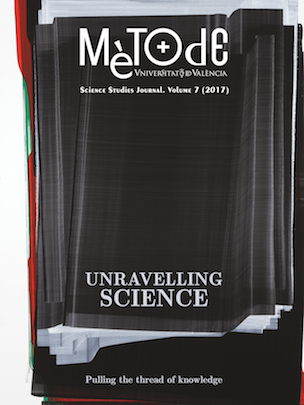Another way of looking at the sky: Neutrino telescopes
DOI:
https://doi.org/10.7203/metode.7.8504Palabras clave:
neutrino astronomy, neutrino telescopes, astroparticle physics, IceCube, KM3NeT Resumen
Resumen
Neutrinos are weakly-interacting neutral particles, which makes them powerful sources of information about the most energetic processes in the universe, such as the origin of ultra-energetic cosmic rays or gamma-ray bursts. However, a price must be paid in order to detect them: gargantuan detectors at the bottom of the sea or under the Antarctic ice are required. The detection of the first high-energy cosmic neutrinos in 2013 by the IceCube observatory represented the start of so-called neutrino astronomy, a new way of observing the universe, which can play a key role in future discoveries. In this article, we describe how neutrino telescopes work, as well as the different initial configurations that made this new twenty-first century astronomy possible.
 Descargas
Descargas
 Citas
Citas
Aartsen, M. G., Abbasi, R., Abdou, Y., Ackermann, M., Adams, J., Aguilar, J. A., … Zoll, M. (2013). Evidence for high-energy extraterrestrial neutrinos at the IceCube Detector. Science, 342, 1242856. doi: 10.1126/science.1242856
Aartsen, M. G., Abraham, K., Ackermann, M., Adams, J., Aguilar, J. A., Ahlers, M., ... Zoll, M. (2015, July 30–August, 6). Observation of astrophysical neutrinos in four years of IceCube data. The 34th International Cosmic Ray Conference (ICRC), The Hague (The Netherlands). Retrieved from http://arxiv.org/abs/1510.05223
Abbott, B. P., Abbott, R., Abbott, T. D., Abernathy, M. R., Acernese, F., & Ackley, K., … Zweizig, J. (2016). Observation of gravitational waves from a binary black hole merger. Physical Review Letters, 116(6), 061102. doi: 10.1103/PhysRevLett.116.061102
Andres, E., Askebjer, P., Bai, X., Barouch, G., Barwick, S. W., Bay, R. C., … Young, S. (2001). Results from the AMANDA high energy neutrino detector. Nuclear Physics B, 91(1-3), 423–430. doi: 10.1016/S0920-5632(00)00971-3
Adrián-Martínez, S., Ageron, M., Aharonian, F., Aiello, S., Albert, A., Ameli, F., … Zúñiga, J. (2016). Letter of Intent for KM3NeT2.0. Journal of Physics G: Nuclear and Particle Physics, 43(8), 084001. doi: 10.1088/0954-3899/43/8/084001
Ageron, M., Aguilar, J. A., Al Samarai, I., Albert, A., Ameli, F., André, M., ... Zúñiga, J. (2011). ANTARES: The first undersea neutrino telescope. Nuclear Instruments and Methods in Physics Research, 656, 11–38. doi: 10.1016/j.nima.2011.06.103
Avrorin, A. D., Avrorin, A. V., Aynutdinov, V. M., Bannasch, R., Belolaptikov, I. A., Bogorodsky, D. Y., … Zurbanov, V. L. (2015). Status and recent results of the Baikal-GVD project. Physics of Particles and Nuclei, 46(2), 211–221. doi: 10.1134/S1063779615020033
Aynutdinov, V., Avrorin, A., Balkanov, V., Belolaptikovd, I., Bogorodsky, D., Budnev, N., … Zhukov, V. (2009). The Baikal neutrino experiment: Physics results and perspectives. Nuclear Instruments and Methods in Physics Research, 602(1), 14–20. doi: 10.1016/j.nima.2008.12.012
Babson, J., Barish, B., Becker-Szendy, R., Bradner, H., Cady, R., Clem, J., … Wilson, C. (1990). Cosmic-ray muons in the deep ocean. Physical Review D, 42(11), 3613–3620. doi: 10.1103/PhysRevD.42.3613
Cowan Jr., C. L., Reines, F., Harrison, F. B., Kruse, H. W., & McGuire, A. D. (1956). Detection of the free neutrino: A confirmation. Science, 124(3212), 103–104. doi: 10.1126/science.124.3212.103
Danby, G., Gaillard, J. M., Goulianos, K., Lederman, L. M., Mistry, N., Schwartz, M., & Steinberger, J. (1962). Observation of high-energy neutrino reactions and the existence of two kinds of neutrinos. Physical Review Letters, 9(1), 36–44. doi: 10.1103/PhysRevLett.9.36
Halzen, F., & Klein, S. R. (2010). IceCube: An instrument for neutrino astronomy. Review of Scientific Instruments, 81(8), 081101. doi: 10.1063/1.3480478
Markov, M. A. (1960, August, 25–September, 1). On high energy neutrino physics. Proceeding for the 10th Annual International Conference on High Energy Physics (ICHEP), Rochester (USA).
Pauli, W. (1930). Letter to Tubingen conference participants. Retrieved from http://goo.gl/XDdTu3
Descargas
Publicado
Cómo citar
-
Resumen886
-
PDF 335
Número
Sección
Licencia
![]()
Todos los documentos incluidos en OJS son de acceso libre y propiedad de sus autores.
Los autores que publican en esta revista están de acuerdo con los siguientes términos:
- Los autores conservan los derechos de autor y garantizan a Metode Science Studies Journal el derecho a la primera publicación del trabajo, licenciado bajo una licencia de Creative Commons Reconocimiento-NoComercial-SinObraDerivada 4.0 Internacional, que permite a otros compartir el trabajo con un reconocimiento de la autoría del trabajo y citando la publicación inicial en esta revista.
- Se permite y se anima a los autores a difundir sus trabajos electrónicamente a través de páginas personales e institucionales (repositorios institucionales, páginas web personales o perfiles a redes profesionales o académicas) una vez publicado el trabajo.





